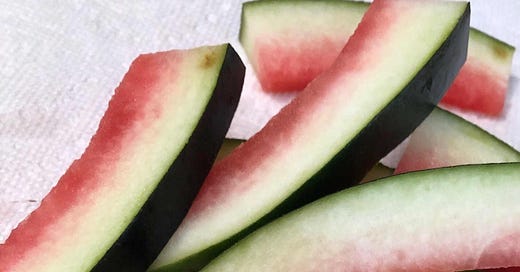
[You might want to first read, A Complicated Berry, on Black’s historical relationship to watermelon.]
Look through any cookbooks by Black authors and it’s a very safe bet that a fondness for watermelon rarely involves anything but watermelon rind pickles.
I’m not really fond of Watermelon. However, I dote on watermelon rind pickles. I spend most summers scheming to be rind from various friends so I can have my pickle without having to eat my way through the melon.—Jessica B. Harris, The Welcome Table: African-American Heritage Cooking
The recipes for the pickle in my own, by now, heavily stained and dogeared, cookbooks are alike with one exception: The oldest use limewater or alum to ensure the rind remains crisp; the newest don’t, which makes it soft. I’ve never pickled because I have a deep-rooted fear of poisoning people, but a friend is a master pickler and tested each recipe.


The older recipes are from Sheila Ferguson and the deeply revered Edna Lewis. Limewater and alum are still available, and my pickler tells me she has used both, but they require a degree of caution because they’re high in alkaline, which makes them prone to causing stomach ailments. There’s also something of a back and forth about whether watermelon pickles should even be crisp.

Jessica B. Harris, the foremost writer and scholar of historical Black cooking, leans on vinegar—cider and, a most modern touch, balsamic. This recipe, below, will bridge the crisp versus soft war, and my pickler loved the balsamic mellow flavoring.
Lewis’s recipe follows—its directions are very comprehensive. Ferguson’s is basically the same, except for the spices—she sticks with the basics of cinnamon, allspice, and cloves, while Lewis substitutes ginger and mace. I would suggest that if you follow Harris’s, read up on how Lewis packs the pickles in the jars and follow suit.
Whichever one you choose, your watermelon pickles will be envied and devoured by family and friends!
Watermelon Rind Pickle Recipes
From Edna Lewis, The Taste of Country Cooking
In the recipe’s preference, Lewis mentions three large, sweet varieties to use—Congo, Tom Watson, and Jackson. They’re all heirlooms now, but I found seed sources for two: Congo and Tom Watson. I’ve put two clarifications to the directions in brackets.
1 large watermelon
Salt and alum solution
1 tablespoon salt
1 teaspoon alum
1 gallon cold water
Syrup
1/2 ounce Ceylon cinnamon stick
2 pieces dried ginger root
1 piece fresh ginger root, if available
2 blades mace
3 pounds sugar
2 pints cider vinegar
3 slices lemon with the seeds removed
Equipment
1 5-quart non-aluminum cooking pot
3 1-quart plus 1 1-pint Mason jars, or a similar combination, sterilized
Cut off the green outer skin of the watermelon and discard any pink flesh left inside, because that becomes very tough when pickled. Cut the trimmed pieces of rind into 2-inch strips or 1 1/2-inch squares, and rinse well. Mix the salt and alum together with the gallon of water, stirring until both are dissolved (the alum is what firms the rind). In the morning remove the rind from the solution and wash in cold water 2 or 3 times. Drain well.
Meanwhile, prepare the syrup by tying the spices in a piece of clean cheesecloth. Dissolve sugar in vinegar. Add the spices and lemon and set over a medium burner. Bring to a gentle boil and cook for 10 minutes.
Now put the rind pieces in the prepared syrup. Place over a medium-high burner. Bring the contents to a gentle boil and cook at a good simmer for 30 minutes. Remove from the burner and let set overnight. Remove the spices. Heat up again the next morning to a gentle boil. Place sterilized Mason jars in a pan of simmering water. When the syrup is heated thoroughly (15 minutes), fill the jars with pieces of rind. Boil up the syrup, then pour it over the pickles, covering them. Insert a dinner knife into each jar, pressing it against the pickles to release any air bubbles. Gently press the pickles under the shoulder of each jar. This will keep the pieces from floating to the top of the jar. See that the syrup is covering the pickles. Wipe the rim of the jar and seal. Remove jars from the stove and set them in a draft-free place until cold. Store in a dry, cool closet.
From Jessica B. Harris, The Welcome Table, African-American Heritage Cookbook
9 cups cubed watermelon rind
1/2 cup salt
2 quarts plus 2 cups water
1 3/4 cups cider vinegar
1/2 cup balsamic vinegar
2 cups sugar
1 lemon, sliced thin
2 sticks cinnamon, crushed
1 teaspoon whole cloves
2 teaspoons cracked allspice
Prepare the watermelon rind by cutting it into 1-inch squares and removing the green skin and all but a small amount of the red flesh. Place the prepared watermelon in a large bowl and soak it overnight in a brine made from the salt and 2 quarts of water.
When ready to prepare, drain the watermelon, wash it with fresh water, and drain again. Place the rind in a large nonreactive saucepan with water to cover, and simmer it until it is fork-tender.
Place the remaining 2 cups of water and all the remaining ingredients in another large nonreactive pan, bring them to a boil, and simmer for 15 minutes, or until you have a thin syrup. Drain the watermelon rind, add it to the syrup, and continue to simmer until the rind becomes translucent. Place the watermelon rind pieces in hot sterilized jars, cover them with the (unstrained) syrup, and seal them according to proper canning procedures. The pickle keep for several months.


